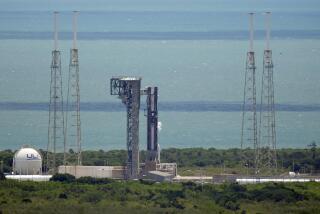Faulty Generator May Shorten Shuttle Flight
- Share via
CAPE CANAVERAL, Fla. — A weakening electric generator on the space shuttle Columbia could force its astronauts to cut short their 16-day science mission and return to Earth as early as Monday.
The generator, called a fuel cell, had been losing voltage since Friday’s liftoff, maybe even before, NASA mission operations director Jeff Bantle said Saturday. If the loss continued at a rapid enough rate, the seven astronauts would have to turn off that fuel cell and land, he said.
By Saturday night, the decline in voltage had slowed considerably. Astronaut Michael Gernhardt said the problem was not interfering with the crew’s round-the-clock laboratory work and that the shuttle was getting all the power it needed.
Brief jumps in voltage were detected in the fuel cell shortly before launch, but shuttle managers determined that the unit was working properly and cleared Columbia for flight.
Columbia’s two other fuel cells were working fine, but National Aeronautics and Space Administration flight rules require that all three be operating properly in orbit.
Neither the shuttle nor crew was in any immediate danger, and laboratory operations were proceeding normally, Bantle said.
The fuel cells use hydrogen and oxygen to produce electricity and water in orbit. If those two fuels mix--a possibility when voltage drops significantly in a fuel cell--the unit could explode.
Bantle cautioned that the fuel cell would be shut down long before there would be any chance for the fuels to mix.
And he emphasized that the voltage could stabilize for good, allowing the astronauts to remain in orbit the full 16 days. Columbia isn’t supposed to return to Kennedy Space Center until April 20.
Most of the degradation occurred within the first 12 hours of the mission, a sign that it could begin to level off, Bantle said.
“Right now, I’d really characterize it as something that’s a little unusual, a little out of [character] from what we’ve seen on fuel cell performance on past flights, something that we’re trying to understand a little better,” he said.
As soon as the problem was detected, NASA formed a special “tiger team” to assess the situation. And scientists began to reorganize their experiments, just in case.
The decreasing voltage could be caused by contamination in the fuel cell. The astronauts were purging the system in hopes of flushing out any possible contaminants.
NASA also was considering having the crew shift some of the power from the degraded fuel cell to the two other units.
A failed fuel cell forced Columbia to return to Earth three days early in 1981. NASA has had to cut short only one other mission because of equipment failure--a military mission by Atlantis in 1991.
More to Read
Sign up for Essential California
The most important California stories and recommendations in your inbox every morning.
You may occasionally receive promotional content from the Los Angeles Times.













